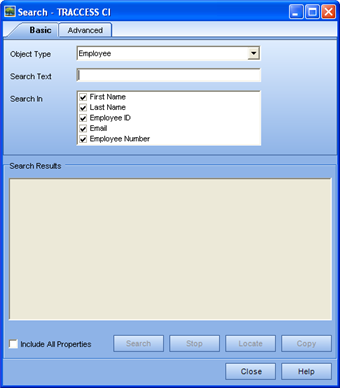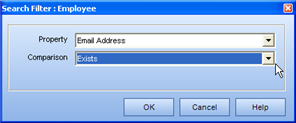
|
|
|
As an assigned employee of the system, you are able to search for objects in the area(s) that you have access to. For example, an employee with a learner role can search for Process Sets, Processes, Sub Processes, Tasks, Tasks with Levels and Resources from the My Job tree. An employee with an Operational Administrator role can search for Organization Units and Employees from the Organization Manager.
There are two methods available to search: basic and advanced. Regardless of the method chosen, there are a few properties that are shared between these methods:
Include All Properties checkbox - if this checkbox is unchecked, a default set of fields will be populated with the search results. If this checkbox is checked, all of the searchable fields for this object will be displayed.
Bottom Buttons
Search - click this button to execute the search
Stop - when carrying out an excessively long search, you can click this button to stop the search action
Locate - once the search has completed, selecting a search result and clicking locate takes you to the selected instance.
Copy - if you would like to further manipulate the search results, use the <Shift> and <Ctrl> keys to select specific search results, and click Copy. You can then paste the contents of the clipboard into another application (i.e., Notepad, Microsoft Word, Microsoft Excel).
To view a copy of a spreadsheet containing all searchable objects, their properties and sample searches for each object, click here.
The basic search allows you to search for objects by simply entering a keyword. Please note that this is an exact search that is looking for particular information in each field. For example, if you are looking for an Employee named Beatrice Agnew, and you enter "Beatrice Agnew" as the search term, your search results will locate nothing. This is because in the Basic Search for an Employee, TRACCESS is searching separately in the First Name and Last Name field. "Beatrice" could be found in the First Name field, and "Agnew" could be found in the Last Name field, but "Beatrice Agnew" would not be found in either.
The advanced search allows you to create search filters on the properties of several objects. For example, Account Created On is a property of an Employee, and you can indicate an exact date, or before/ after a date. The advanced search also allows you to create more than one filter, then state whether it is a "match all" or "match any" search.
Match All - if you indicate more than one search filter, selecting this option indicates than all search requirements must be met.
Match Any - if you indicate more than one search filter, selecting this option indicates than any search requirements can be met.
You may also wish to Search using Regular Expressions. For more information, see Interpret Regular Expressions.
The Search dialog appears. 

The Search Results dialog will be populated.
The program will navigate to the selected Search Result.
The Search dialog appears. 

The Search Filters dialog appears. 

Depending on the Object and Property selected, you may see either two or three dropdown fields to populate. For example, when the Employee Object/ Account Created On Property/ Exists Comparison is selected, there is no need for a Value field. However, a filter of Employee Object/ Account Created On Property/ Before Comparison requires you to enter a Date value.
The Match All option is selected by default. Therefore, if you have more than one filter created, this indicates that you wish to only retrieve results that match all of the filters that have been set.
The Search Results dialog will be populated.
The program will navigate to the selected Search Result.
|
|
|
|